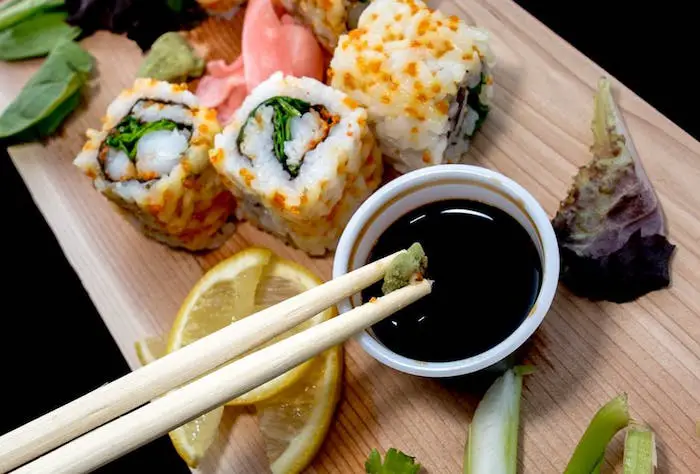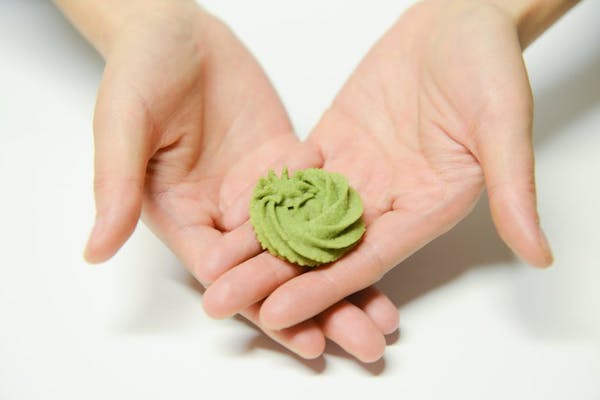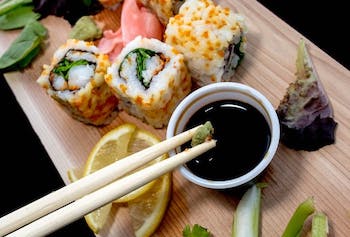We are reader supported. When you purchase through links on our site, we may earn an affiliate commission. Also, as an Amazon affiliate, we earn from qualifying purchases.

Whether I order sushi at my favorite sushi restaurant or make them at home, my platter is not complete until I have the spicy green sauce on the side. I just can’t imagine eating my raw fish without it because it delivers a kind of kick that enhances the overall flavor.
But, do you know – what is the green spicy sushi sauce? Most people will say wasabi, but actually what you have on your plate is not real wasabi but a fake version. It is made of old horseradish, mixed with citric acid, mustard extract, blue dye no 5, and yellow dye no 5. Surprised? Read on to know more.
This wasabi-lookalike served in most restaurants around the world comes in the form of powder in big sized industrial bags. The chef mixes the powder with water to make a green paste or sauce like consistency to be served with sushi rolls, nigiri, and sashimi.
Contents
Why Do Sushi Restaurants Don’t Serve The Real Wasabi?
Wasabi plant has earned the reputation of being one of the hardest to grow crops in the world. To cultivate it successfully, you must ensure that it does not get direct sunlight or too much of shade. It grows well only in a mild climate that is not too hot or too cold.
In Japan, wasabi is grown in the mountainous regions where a constant supply of spring water is provided for the plants to thrive. Wasabi grows best in small sized plots instead of large farms. Even if the slightest mistake occurs, the entire crop goes bad and the farmer has to wait until next season because it has a long maturity cycle.
As farmers are only able to cultivate only a limited amount of wasabi plants every season, there is always more demand than supply. No wonder real wasabi has a big price tag attached to it (costing about $160 per kilogram).
If the restaurants start providing real wasabi paste, this will increase the overall price of the sushi platter and guests are not used to paying high for a condiment. As a result, most restaurants use a cheaper substitute made from horseradish and other ingredients.
How To Make Green Spicy Sushi Sauce?
In the supermarket, you can find wasabi in powder form and it usually consists of horseradish powder, mustard powder, cornstarch, and green coloring. To make your own green spicy sauce, follow these steps:
• Mustard powder (powdered or fresh)
• Horseradish powder
• Food coloring (green)
• Water
Mix equal parts of mustard powder and horseradish powder. Add a few drops of food coloring and add some water until you get the desired consistency of the imitation wasabi paste.
The above-mentioned sauce has a hot flavor to it, which may be suitable for salmon and tuna but it does not go well with the more delicate fish. For the seafood and fish with subtle flavors, I would recommend another alternative:
Chop some parts of fresh green scallions and use a food processor to puree them to make a fine paste. To add some ‘heat’ to the paste, grate a small portion of daikon raddish or horseradish (remove excess liquid by squeezing the paste). Now add this to the scallion puree and you have a nice green sauce ready to go with sashimi without overpowering the flavor of subtle fish.
To make real wasabi paste at home, check out the detailed instructions and other useful information provided in this article.
Difference Between Real Wasabi And Wasabi Mix
Physical appearance:

Real wasabi side is prepared using the freshly ground root of the plant and it is then packed into small mounds and served with your sushi meal. So, the real paste will not have the texture of a paste or sauce. It is more like a clump made of the finely grated root.

The powdered form on the other hand is mixed with water to give you fake wasabi, so they don’t have a similar texture. The real wasabi has a much lighter hue than fake wasabi because the root’s original color is usually lighter than the dye used to imitate it.
Taste and flavor:
The real wasabi is a condiment that enhances the delicate taste of raw fish, taking it to a different level altogether. While it does not really taste spicy, it has an aroma that resembles ‘spiciness’ without the hot punch arising from additional ingredients.
Mix wasabi has a strong taste that can burn your mouth with intense heat. It may often over rules the delicate taste of raw fish. It delivers a spicy punch to the taste buds and that spiciness comes from the presence of mustard seed flour.
Root or stem?
Real wasabi is not the root, but the stem part or rhizome of the plant that belongs to the Brassica family. It includes broccoli, cabbage, mustard, and Brussels sprouts.
Mix wasabi is usually made from horseradish, which is a root containing brown exterior skin and white inside. You get a white paste when grated hence green coloring is added to make it look like wasabi.
Both real and mix wasabi have a kind of pungent taste but the real wasabi has a sweetness to it, which is lacking in the horseradish paste. So, the next time you get mix wasabi on your sushi plate and it makes your nose run, you should know that is not wasabi.
Growing conditions
Real wasabi and horseradish also varies in their growing conditions. While the later takes about three years to attain full maturity, the horseradish grows rapidly. In the US, wasabi thrives in Illinois, which produces nearly two-thirds of the crop.
Real wasabi requires specific microclimate with lots of shade and water to grow while horseradish needs minimal maintenance. The harvest time for horseradish usually takes place in September and lasts through April when the ground stays cold. According to expert, horseradish retains its best quality when it’s cold.
Due to the specific conditions needed to grow wasabi, real wasabi is extremely difficult to find outside of Japan. As a result, the condiment is rare and expensive in any form. Most restaurants use horseradish powder or paste as a substitute.
Freshness period
Another important factor that distinguishes fake wasabi from the real thing is that the later must be served immediately after grating. If real wasabi (grated) is left out, it can lose its intensity in just 15 minutes. In some restaurants, they will tuck in the wasabi in between food to ensure that its freshness remains intact.
Please note that real wasabi is not too strong in flavor, so that tingling you feel in the nasal passage is basically because your are eating the fake thing! Real wasabi has a herbal taste and a tint of sweetness in the background.
Where Do You Get The Real Green Condiment (Real Wasabi)?
The answer is Japan where the traditional food is grown and consumed since centuries. Some high-end restaurants in Japan use fresh wasabi root to create the side while others create a mix of wasabi and horseradish to retain a bit of the real flavor.
The pioneering effects of wasabi-loving Americans have made cultivation of wasabi possible in the US. You can now find real wasabi paste in several sushi bars in America. In the western countries, it is mostly sold in the powered form that can be mixed with water to form a paste.
Related Questions
Why does my favorite sushi bar serve fake wasabi
The green spicy sushi sauce that gives you a hot punch in the nose is actually fake wasabi but don’t get disappointed. It’s not just your favorite sushi bar but most of the restaurants around the world serve the fake stuff. As real wasabi is rare to find and pretty expensive too, the restaurants/ bars use substitutes that give a similar effect.
How Can I Tell Whether I Am Eating Real Wasabi?
If you are served real wasabi, it will appear coarse than the powder-made paste. It also does not feel so blazing and sharp. In fact, the real wasabi will pack a temporary punch and feel like a pleasurable knock on the taste buds. The fake powdered wasabi on the other hand has a shocking effect on the palate and it can overwhelm the subtle flavors of delicate raw fish.
I have been eating fake wasabi for years. Why bother for real thing?
Most people outside Japan have been eating fake wasabi with sushi and it feels just fine. However, if you ever get the opportunity to enjoy fresh wasabi paste, you will know the difference as the sweet herbal flavor envelops your mouth. Trust me, you will not want to settle for the fake green spicy sushi sauce again.
Why You Should Not Add Extra Wasabi To Sushi?
Your chef already adds some amount of wasabi to sushi and knows exactly how much is enough to maintain the balance of flavor. As fake wasabi has a lot of heat, adding extra to your sushi rolls can make your meal too spicy and hot to enjoy with the delicate flavor or rice and raw fish.
Is It Against Sushi Etiquettes To Mix Wasabi With Soy Sauce?
Many Japanese prefer to mix the green spicy sushi sauce with soy sauce while enjoying sashimi or sushi rolls. However, the sushi traditionalists prefer putting wasabi directly on the sashimi rather than mixing it with soy sauce because they feel wasabi loses its original flavor when mixed.
Related Article: How Much Does A Wasabi Root Weigh?


Comments
Pingback: How to Make Real Wasabi at Home? - Easy Homemade Sushi